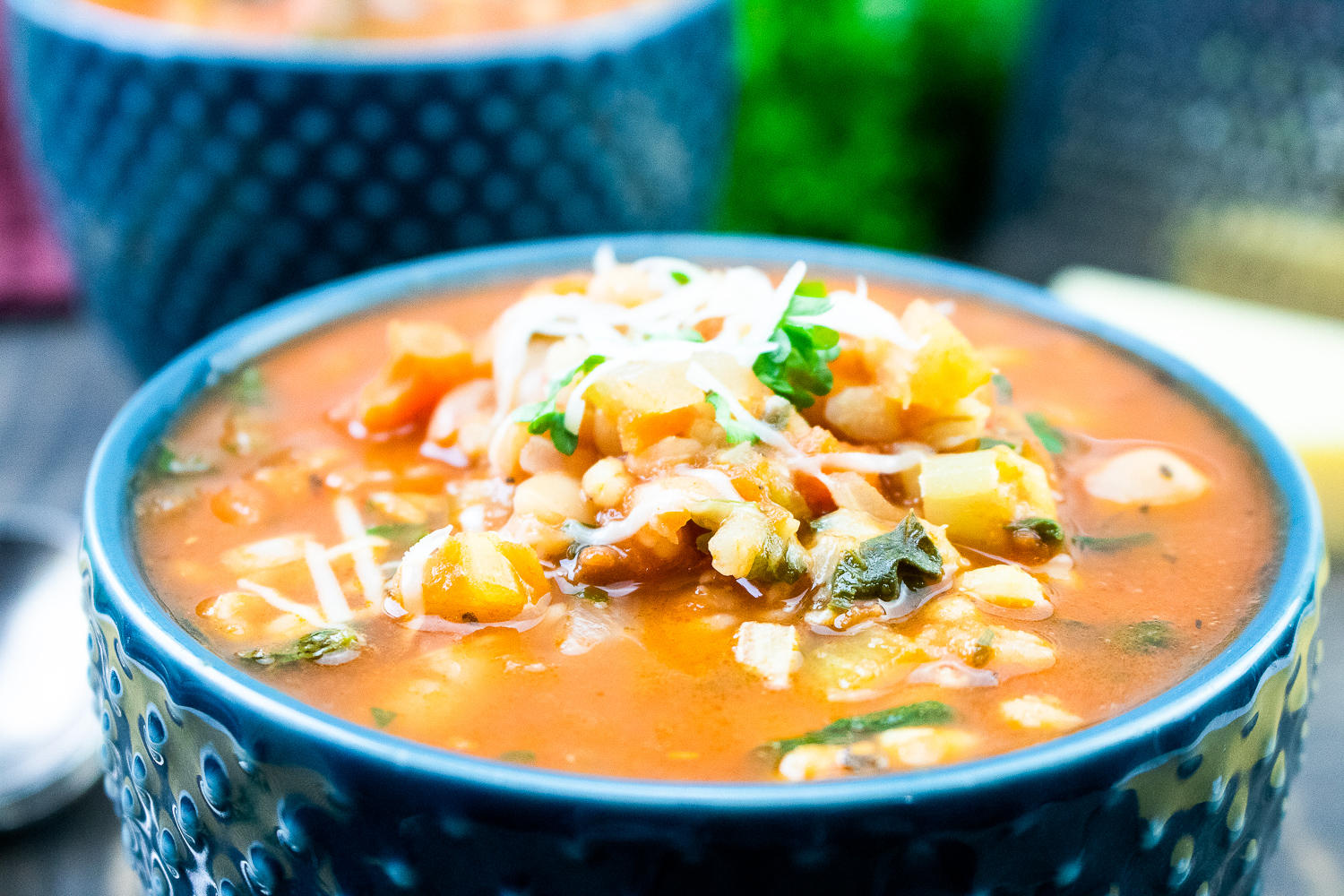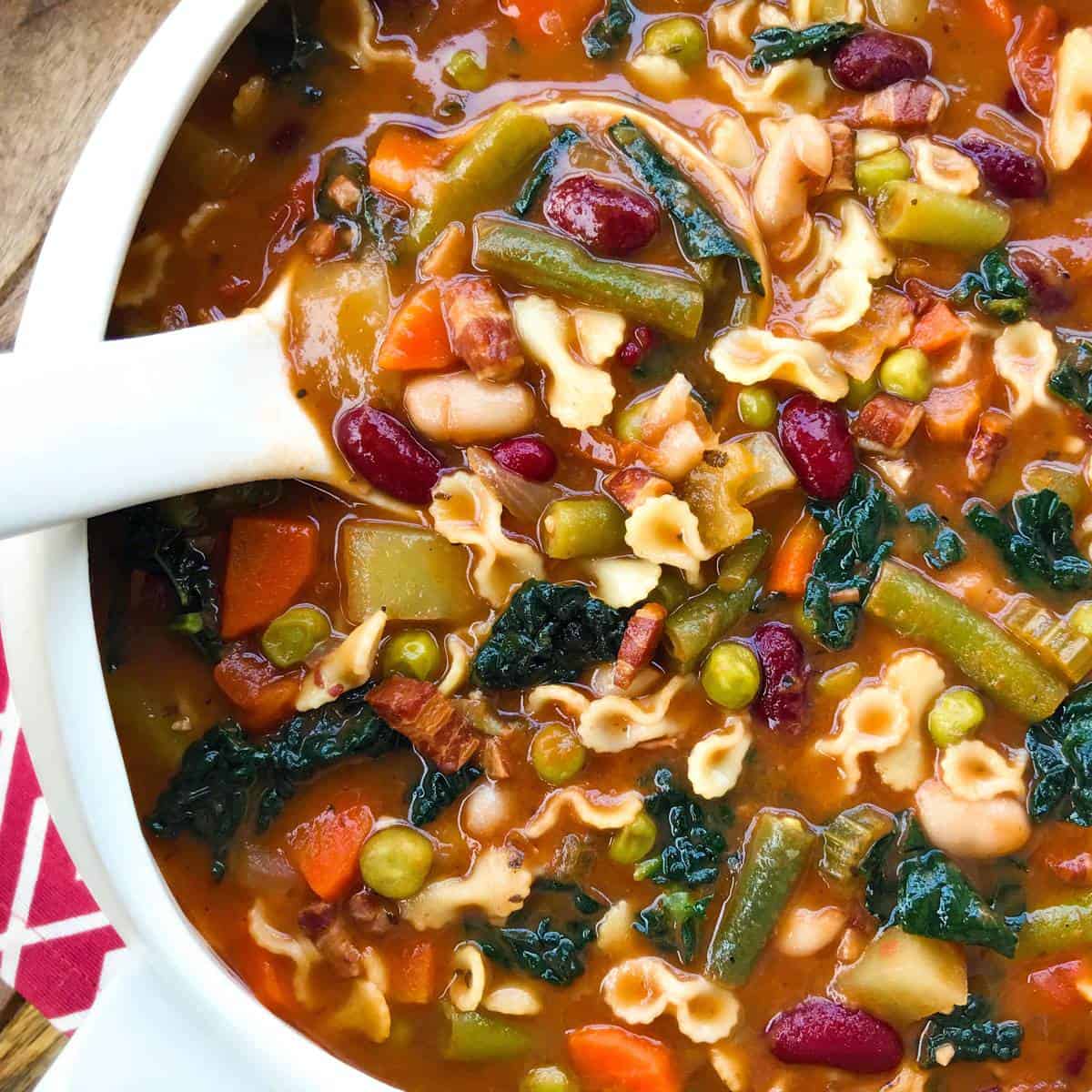Embark on a delectable expedition into the realm of traditional minestrone soup, a culinary masterpiece steeped in history and brimming with wholesome goodness. This hearty and comforting dish, originating from the humble kitchens of Italy, has captivated taste buds for centuries with its vibrant medley of vegetables, aromatic herbs, and savory broth.
In this comprehensive guide, we will delve into the essence of traditional minestrone soup, exploring its origins, essential ingredients, and the art of crafting this culinary treasure. We will uncover the secrets of achieving the perfect balance of flavors and textures, unravel the regional variations that have shaped its evolution, and discover the myriad ways to savor this nourishing and versatile dish.
Introduction
Minestrone soup is a traditional Italian vegetable soup that is made with a variety of ingredients, including beans, vegetables, pasta, and sometimes meat. It is believed to have originated in the 16th century in the northern Italian region of Lombardy.
Minestrone soup is a hearty and flavorful soup that is perfect for a cold winter day.
Origins and History
The origins of minestrone soup are humble. It is believed to have originated as a peasant dish made with whatever vegetables were available. Over time, minestrone soup became more popular and began to be made with a wider variety of ingredients.
Today, minestrone soup is a staple of Italian cuisine and is enjoyed by people all over the world.
Ingredients
A traditional minestrone soup recipe requires a combination of fresh vegetables, beans, and herbs to create its hearty and flavorful broth.
Each ingredient plays a specific role in contributing to the overall taste and texture of the soup:
Vegetables
- Celery: Adds a subtle celery flavor and aroma to the broth.
- Carrots: Provide sweetness and a vibrant orange color.
- Onions: Create a savory base for the soup and enhance the flavors of other ingredients.
- Garlic: Infuses the soup with a pungent and aromatic flavor.
- Potatoes: Thicken the soup and provide a starchy texture.
- Green beans: Add a crisp texture and a bright green color.
Beans
- Cannellini beans: White kidney beans that contribute a creamy texture and mild nutty flavor.
- Great Northern beans: Smaller white beans that add a slightly sweet and earthy taste.
Herbs
- Basil: Provides a fresh and aromatic flavor.
- Thyme: Adds a warm and earthy aroma.
- Rosemary: Infuses the soup with a piney and herbaceous flavor.
Cooking Methods

To create a delicious and flavorful traditional minestrone soup, follow these simple steps:
Begin by heating olive oil in a large pot over medium heat. Add chopped onion, carrots, and celery and cook until softened. Stir in minced garlic and cook for an additional minute.
Sautéing Vegetables
Sautéing the vegetables enhances their flavor and sweetness. Cook them until they are tender but still have a slight crunch.
Adding Tomatoes and Broth
Add chopped tomatoes, vegetable broth, and water to the pot. Bring to a boil, then reduce heat and simmer for 15 minutes.
Cooking Pasta and Beans
Add pasta and beans to the soup and cook according to the package directions. Pasta should be cooked al dente, with a slight bite.
Finishing Touches
Once the pasta and beans are cooked, stir in chopped greens, such as kale or spinach. Season with salt, pepper, and dried oregano. Simmer for an additional 5 minutes, or until the greens are wilted.
4. Variations
Minestrone soup has many regional variations, each with its unique ingredients and flavors.
Ligurian Minestrone
Ligurian minestrone, from the Liguria region of Italy, is known for its use of pesto and green beans. It also often includes potatoes, carrots, celery, and tomatoes.
Tuscan Minestrone
Tuscan minestrone, from the Tuscany region of Italy, is made with a variety of beans, including cannellini beans, kidney beans, and chickpeas. It also typically includes vegetables such as carrots, celery, onions, and tomatoes.
Venetian Minestrone
Venetian minestrone, from the Veneto region of Italy, is made with a combination of rice and pasta. It also often includes vegetables such as carrots, celery, onions, and tomatoes.
Serving Suggestions
Traditional minestrone soup is a versatile dish that can be enjoyed in various ways. Whether served as a light appetizer or a hearty main course, there are several options to enhance its presentation and complement its flavors.
Garnishes and accompaniments play a crucial role in elevating the dining experience. Consider adding freshly grated Parmesan cheese, chopped fresh basil or parsley, a drizzle of high-quality olive oil, or a sprinkle of red pepper flakes for a touch of spice.
These toppings not only add visual appeal but also enhance the overall flavor profile.
Bread Accompaniments
Crust bread, such as sourdough or ciabatta, is an excellent choice for dipping into the flavorful broth of minestrone soup. The bread’s rustic texture and slightly sour flavor pair well with the soup’s richness. Alternatively, a side of crispy croutons can add a satisfying crunch and extra texture.
Side Salads
A fresh and light side salad can complement the hearty nature of minestrone soup. Consider a simple green salad with a lemony vinaigrette dressing or a more elaborate salad with mixed greens, roasted vegetables, and a tangy balsamic dressing. The acidity and freshness of the salad will balance the soup’s richness.
Nutritional Value

Traditional minestrone soup is not only delicious but also packed with nutritional goodness. It is a rich source of vitamins, minerals, and antioxidants, making it a healthy and satisfying meal.
One serving of minestrone soup typically contains the following nutrients:
- Calories: 150-200
- Protein: 10-15 grams
- Carbohydrates: 25-30 grams
- Fat: 5-10 grams
- Fiber: 5-10 grams
- Vitamin A: 100% of the daily recommended value (DV)
- Vitamin C: 50% of the DV
- Vitamin K: 20% of the DV
- Potassium: 10% of the DV
- Magnesium: 10% of the DV
Health Benefits
The high nutritional content of minestrone soup provides several health benefits, including:
- Improved digestion: The fiber in minestrone soup helps to regulate digestion and prevent constipation.
- Reduced risk of heart disease: The antioxidants in minestrone soup help to protect against heart disease by reducing inflammation and lowering cholesterol levels.
- Boosted immunity: The vitamins and minerals in minestrone soup help to boost the immune system and protect against infection.
- Weight management: The low calorie and high fiber content of minestrone soup make it a filling and satisfying meal that can help with weight management.
Dietary Considerations
Minestrone soup is generally a healthy and nutritious meal for most people. However, there are a few dietary considerations to keep in mind:
- Sodium: Minestrone soup can be high in sodium, so it is important to choose a low-sodium variety or to reduce the amount of salt added during cooking.
- FODMAPs: Minestrone soup may contain high-FODMAP ingredients, such as onions, garlic, and beans. People with irritable bowel syndrome (IBS) may need to avoid or limit their intake of minestrone soup.
Closing Summary
As we bid farewell to our exploration of traditional minestrone soup, let us savor the lingering flavors and the warmth it brings to our hearts and tables. This culinary masterpiece, with its humble origins and timeless appeal, continues to inspire and nourish generations.
Whether enjoyed as a comforting meal on a chilly evening or as a vibrant centerpiece of a festive gathering, traditional minestrone soup stands as a testament to the enduring power of simple, wholesome ingredients and the art of cooking with love.
FAQ Corner
What is the history behind traditional minestrone soup?
Minestrone soup traces its roots back to the humble kitchens of Italy in the Middle Ages. It was originally a peasant dish, made with whatever vegetables were available, and often thickened with stale bread or rice. Over time, it evolved into a more refined dish, with the addition of meat and other ingredients.
What are the essential ingredients for traditional minestrone soup?
The essential ingredients for traditional minestrone soup include: vegetables (such as carrots, celery, onions, and tomatoes), beans (such as kidney beans or cannellini beans), pasta (such as ditalini or elbow macaroni), and broth (such as chicken or vegetable broth).
What are some tips for making the best traditional minestrone soup?
To make the best traditional minestrone soup, use fresh, high-quality ingredients. Sauté the vegetables in olive oil to enhance their flavor. Add the beans and pasta to the soup towards the end of cooking, to prevent them from becoming overcooked.
Season the soup to taste with salt and pepper, and add fresh herbs, such as basil or oregano, for extra flavor.
